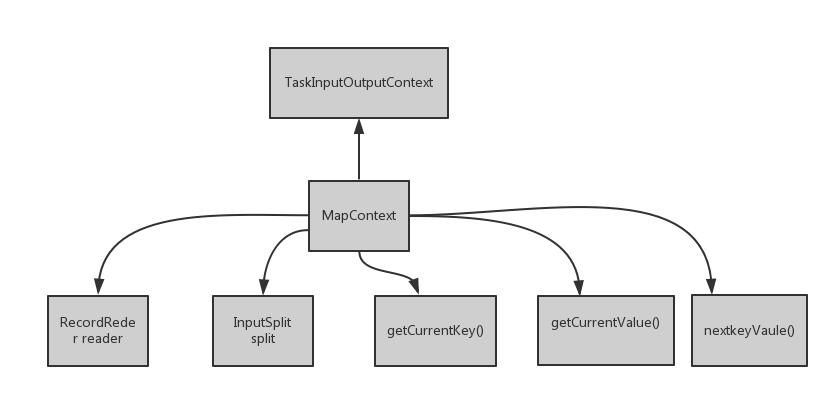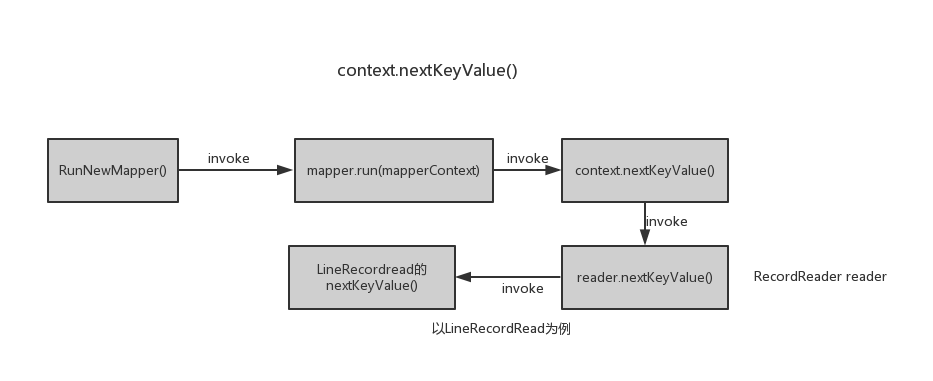InputSplit—>RecordReder—>map(key,value,context)的过程解析

上图首先描述了在TaskTracker端Task(MapTask、ReduceTask)的执行过程,MapTask(org.apache.hadoop.mapred)首先被TaskRunner调用,然后在MapTask内部首先进行一些初始化工作,然后调用run()方法,判断如果使用了新版API就调用RunNewMapper()开始执行Map操作。
1)runNewMapper()分析
1.首先创建一个Mapper对象
// make a mapper
org.apache.hadoop.mapreduce.Mapper<INKEY,INVALUE,OUTKEY,OUTVALUE> mapper =
(org.apache.hadoop.mapreduce.Mapper<INKEY,INVALUE,OUTKEY,OUTVALUE>)
ReflectionUtils.newInstance(taskContext.getMapperClass(), job);
2.创建一个InputFormat对象
org.apache.hadoop.mapreduce.InputFormat<INKEY,INVALUE> inputFormat =
(org.apache.hadoop.mapreduce.InputFormat<INKEY,INVALUE>)
ReflectionUtils.newInstance(taskContext.getInputFormatClass(), job);
3.创建InputSplit对象
org.apache.hadoop.mapreduce.InputSplit split = null;
split = getSplitDetails(new Path(splitIndex.getSplitLocation()),
splitIndex.getStartOffset());//获得分片的详细信息
其中,splitIndex是TaskSplitIndex类型(用于指示此mapTask处理的分片),TaskSplitIndex有两个字段:
String splitLocation //job.split在HDFS上的路径
long startOffset //此次处理的分片在job.split中的位置。
利用上述两个字段首先找到job.split,然后就可以在startOffset的位置处找到这次处理的分片的详细信息。
4.利用InputFormat和InputSplit创建RecordReader对象input,这里应该是已经确定了input具体是那种记录读取器,例如LineRecordReader
org.apache.hadoop.mapreduce.RecordReader<INKEY,INVALUE> input =
new NewTrackingRecordReader<INKEY,INVALUE>
(split, inputFormat, reporter, job, taskContext);
5.创建输出收集器OutputCollector对象output(如果reduce=0创建NewDirectOutputCollector类对象,否则创建NewOutputCollector类对象)
// get an output object
if (job.getNumReduceTasks() == 0) {//reduce数量如果是0
output =
new NewDirectOutputCollector(taskContext, job, umbilical, reporter);
} else {
output = new NewOutputCollector(taskContext, job, umbilical, reporter);
}
6.利用上述对象创建MapContext类的对象mapperContext
mapperContext = contextConstructor.newInstance(mapper, job, getTaskID(),
input, output, committer,
reporter, split);

其中reader和split是数据成员,getCurrentKey()是获得当前的key,同样getCurrentValue().如果还有下条记录,nextKeyValue()返回true,否则返回false,这三个方法均由reader调用。由于RecordReader是抽象类,并未实现相关方法,其子类实现了这些方法。
@Override
public KEYIN getCurrentKey() throws IOException, InterruptedException {
return reader.getCurrentKey();
} @Override
public VALUEIN getCurrentValue() throws IOException, InterruptedException {
return reader.getCurrentValue();
} @Override
public boolean nextKeyValue() throws IOException, InterruptedException {
return reader.nextKeyValue();
}
在MapContext的构造函数中,字段reader就是由input初始化的,所以reader的具体类型也是已经确定了的,所以会调用具体实现了的这些方法,例如LineRecorReader的方法
(在org.apache.hadoop.mapreduce.lib.input中找到,因为新版API重写了LineRecordReader),以下是LineRecordReader部分源码():
private CompressionCodecFactory compressionCodecs = null;
private long start;
private long pos;
private long end;
private LineReader in;
private int maxLineLength;
private LongWritable key = null;
private Text value = null;
private Seekable filePosition;
private CompressionCodec codec;
public void initialize(InputSplit genericSplit,
TaskAttemptContext context) throws IOException {
FileSplit split = (FileSplit) genericSplit;
Configuration job = context.getConfiguration();
this.maxLineLength = job.getInt("mapred.linerecordreader.maxlength",
Integer.MAX_VALUE);
start = split.getStart();
end = start + split.getLength();
final Path file = split.getPath();
compressionCodecs = new CompressionCodecFactory(job);
codec = compressionCodecs.getCodec(file); // open the file and seek to the start of the split
FileSystem fs = file.getFileSystem(job);
FSDataInputStream fileIn = fs.open(split.getPath()); if (isCompressedInput()) {
decompressor = CodecPool.getDecompressor(codec);
if (codec instanceof SplittableCompressionCodec) {
final SplitCompressionInputStream cIn =
((SplittableCompressionCodec)codec).createInputStream(
fileIn, decompressor, start, end,
SplittableCompressionCodec.READ_MODE.BYBLOCK);
in = new LineReader(cIn, job);
start = cIn.getAdjustedStart();
end = cIn.getAdjustedEnd();
filePosition = cIn;
} else {
in = new LineReader(codec.createInputStream(fileIn, decompressor),
job);
filePosition = fileIn;
}
} else {
fileIn.seek(start);
in = new LineReader(fileIn, job);
filePosition = fileIn;
}
// If this is not the first split, we always throw away first record
// because we always (except the last split) read one extra line in
// next() method.
if (start != 0) {
start += in.readLine(new Text(), 0, maxBytesToConsume(start));
}
this.pos = start;
}
@Override
public LongWritable getCurrentKey() {
return key;
} @Override
public Text getCurrentValue() {
return value;
}
7-8行可看到类的字段key和value。使用initialize()方法初始化,读取分片中的数据到key/value由nextKeyValue()方法完成:
public boolean nextKeyValue() throws IOException {
if (key == null) {
key = new LongWritable();
}
key.set(pos);//以记录的偏移量为key
if (value == null) {
value = new Text();
}
int newSize = 0;
// We always read one extra line, which lies outside the upper
// split limit i.e. (end - 1)
while (getFilePosition() <= end) {
//获取value值,调用了很多的函数
newSize = in.readLine(value, maxLineLength,
Math.max(maxBytesToConsume(pos), maxLineLength));
if (newSize == 0) {
break;
}
pos += newSize;//更新pos
if (newSize < maxLineLength) {
break;
}
// line too long. try again
LOG.info("Skipped line of size " + newSize + " at pos " +
(pos - newSize));
}
if (newSize == 0) {
key = null;
value = null;
return false;
} else {
return true;
}
}
7.初始化记录读取器input(例如LineRecordReader.initialize())
input.initialize(split, mapperContext);
8.调用Mapper类的run()方法:
mapper.run(mapperContext);
Mapper类结果如下所示:

Mapper有一个内部类Context。通过run()方法调用这几个方法,run()的实现如下所示:
public void run(Context context) throws IOException, InterruptedException {
setup(context);
try {
while (context.nextKeyValue()) {
map(context.getCurrentKey(), context.getCurrentValue(), context);
}
} finally {
cleanup(context);
}
}
从MapTask的角度分析下Mapper中的run()方法内的context.nextkeyValue(),流程图如下所示:

上面已经给出了LineRecordRead的源码,以下做简要分析:
LineRecordRead有3个核心字段,分别是pos,key,value。pos就是读取的字段在文件中的偏移量,每次通过nextKeyValue()方法中读取分片中一个记录,并将pos设置为此记录的key,然后再将此记录存储在value中,最后更新pos的值,作为下个字段的偏移量。最后,nextKeyValue方法返回一个布尔值,true表示成功读取到一条记录,否则,表示此分片中已没有记录。
然后执行map(context.getCurrentKey(), context.getCurrentValue(), context),其中context.getCurrentKey()调用了LineRecordRead的方法getCurrentKey()直接返回当前key,context.getCurrentValue()也是同样。
2)基于以上的分析,MapTask的任务逻辑图如下所示:

其中输入分片就是由上述的第2、3完成的。RecordReader就对应了第4步的记录读取器input对象。OutputCollector对应第5步中的输出收集器对象output。第8步就对应了上图中的Mapper,接下来就分析Mapper之后发生了什么,这就要进入到Mapper类的map()方法内部:
用户要重写Mapper的map方法,这里以WordCount为例进行分析。重写的map方法如下所示;
public void map(Object key, Text value, Context context
) throws IOException, InterruptedException {
StringTokenizer itr = new StringTokenizer(value.toString());
while (itr.hasMoreTokens()) {
word.set(itr.nextToken());
context.write(word, one);
}
}
关注最后一行代码:context.write(word,one),一直Context是Mapper的内部类,继承自MapContext类,那么这个write方法究竟做了什么呢?以下是整个调用过程:
context.write(word, one);
Context类只是简单的继承了MapContext类,并没有write方法,查看MapContext有没有write方法,结果MapContext也没有write方法,继续查看MapContext的父类TaskInputOutputContext,其中write方法源码为:
public void write(KEYOUT key, VALUEOUT value
) throws IOException, InterruptedException {
output.write(key, value);
}
output是此类的一个字段,定义如下:
private RecordWriter<KEYOUT,VALUEOUT> output;
而RecordWriter是一个抽象类,没有字段,只有未实现的抽象方法write和close,Context通过继承机制,获得了output字段,这个字段肯定是RecordWriter的某个具体实现类,到底是哪个类呢?转了一圈,我们看看context对象的来源:就是在RunNewMapper中(对应第8步)
mapper.run(mapperContext);
mapper就是一个Mapper对象,调用其run方法:
public void run(Context context) throws IOException, InterruptedException {
setup(context);
try {
while (context.nextKeyValue()) {
map(context.getCurrentKey(), context.getCurrentValue(), context);
}
} finally {
cleanup(context);
}
}
将mapperContext对象赋值给了context对象,也就是context的来源是mapperContext对象,那我们就需要看看mapperContext是怎么来的:
org.apache.hadoop.mapreduce.Mapper<INKEY,INVALUE,OUTKEY,OUTVALUE>.Context mapperContext = null;
mapperContext = contextConstructor.newInstance(mapper, job, getTaskID(),input, output, committer,reporter, split);
首先mapperContext对象是Context类型,然后就是第二行代码的作用就相当于使用new Context(....)创建新对象。是时候上图了:

super就是调用父类的构造函数。再次贴上mapperContext创建的代码:
mapperContext = contextConstructor.newInstance(mapper, job, getTaskID(),input, output, committer,reporter, split);
job就对应于conf,getTaskID()就对应于taskid,input对应reader,output对应writer,...。通过观察这三个类的构造函数,不能看出最终output对象传值给了TaskInputOutputContext类中的RecordReader output对象。再回到这个output的定义:
// get an output object
if (job.getNumReduceTasks() == 0) {//reduce数量如果是0
output =
new NewDirectOutputCollector(taskContext, job, umbilical, reporter);
} else {
output = new NewOutputCollector(taskContext, job, umbilical, reporter);
}
这样我们就可以确定TaskInputOutputContext中字段output的类型是NewOutputCollector类型(RecordWriter抽象类的一个实现)。
当然,context继承了TaskInputOutputContext这个output字段,更重要的还有其write方法。对Context类做个小结,到目前为止所知道的它的字段和方法如下:

再回到map方法:
public void map(Object key, Text value, Context context
) throws IOException, InterruptedException {
StringTokenizer itr = new StringTokenizer(value.toString());
while (itr.hasMoreTokens()) {
word.set(itr.nextToken());
context.write(word, one);
}
}
可以看到context.write()方法其实就是调用了NewOutputCollector类的write方法,这个类部分声明:
private final MapOutputCollector<K,V> collector;//map的输出内存缓冲区。
private final org.apache.hadoop.mapreduce.Partitioner<K,V> partitioner;//作业所使用的分区(Partitioner)类型(默认的Partitioner就是HashPartitioner)
private final int partitions;//reduce的数量
NewOutputCollector(org.apache.hadoop.mapreduce.JobContext jobContext,
JobConf job,
TaskUmbilicalProtocol umbilical,
TaskReporter reporter
) throws IOException, ClassNotFoundException {
collector = new MapOutputBuffer<K,V>(umbilical, job, reporter);//创建collector对象
partitions = jobContext.getNumReduceTasks();//获得reduce的数量。
if (partitions > 0) {
partitioner = (org.apache.hadoop.mapreduce.Partitioner<K,V>)
ReflectionUtils.newInstance(jobContext.getPartitionerClass(), job);//获得作业所使用的分区(Partitioner)类型(默认的Partitioner就是HashPartitioner)
} else {
partitioner = new org.apache.hadoop.mapreduce.Partitioner<K,V>() {
@Override
public int getPartition(K key, V value, int numPartitions) {
return -1;
}
};
}
}
public void write(K key, V value) throws IOException, InterruptedException {
collector.collect(key, value,
partitioner.getPartition(key, value, partitions));
}
NewOutputCollector有三个数据成员:collector、partitioner和partitions,这三个字段都在构造函数内完成初始化,collector是MapOutputBuffer类的对象,是本类的核心字段,partitioner是Partitioner类的对象,用于指示本次map所使用的分区类型,所谓的对key/value分区的过程其实也就是调用getPartition(key,value,reduceNums)方法返回一个整数作为此键值对的分区号,用户可以自定义分区类,其实也就是自定义getPartition(key,value,reduceNums)方法。不过分区只是根据key将map的输出分成不同的区(以0,1,2,3等数字作为分区号),每个区用一个reduce处理。默认的分区方法是HashPartitioner,首先将key的哈希值和Integer类型最大值进行与运算,然后将结果对作业的reduce数量取模值,将这个模值作为此key/value对应的分区号,可见键值对的分区号只是与key有关,其原型如下:
public class HashPartitioner<K, V> extends Partitioner<K, V> {
/** Use {@link Object#hashCode()} to partition. */
public int getPartition(K key, V value,
int numReduceTasks) {
return (key.hashCode() & Integer.MAX_VALUE) % numReduceTasks;
}
接下来查看到NewOutputCollector的write方法又调用了collector.collect(key,value)方法:
public void write(K key, V value) throws IOException, InterruptedException {
collector.collect(key, value,
partitioner.getPartition(key, value, partitions));
}
不深入collect方法内部看的话,看到此方法的第一印象就是colllector将key、value、partition(对应的分区号)一起存入内存缓冲区。接下来分析map阶段的spill过程。
参考:
http://zheming.wang/hadoop-mapreduce-zhi-xing-liu-cheng-xiang-jie.html
InputSplit—>RecordReder—>map(key,value,context)的过程解析的更多相关文章
- context创建过程解析(一)之deployDescriptors
总结:主要是创建Context对象,并且将默认context配置,host级别配置,context配置的值设置进去,设置docBase,如果是war包就解压到webapp的目录中,重新设置docBas ...
- context创建过程解析(三)之deployDirectories
HostConfig.deployApps() //在监听到start事件类型,也就是StandardHost调用startInternal protected void deployApps() { ...
- context创建过程解析(二)之deployWARs
HostConfig.deployApps() //在监听到start事件类型,也就是StandardHost调用startInternal protected void deployApps() { ...
- map写数据到本地磁盘过程解析----spill和merge
如上次分析,其实map函数中的context.write()调用过程如下所示: 梳理下调用过程,context的write方法其实是调用了TaskInputOutputContext类的write方法 ...
- Map<Key,Value>基于Value值排序
Map<Key,Value> 排序默认是按照KEY值的升序来进行. 针对按照Value来进行排序有两种方法: 第一种 使用TreeMap 代码如下 public class test{ ...
- TaskTracker执行map或reduce任务的过程2
TaskTracker执行map或reduce任务的过程(二) 上次说到,当MapLauncher或ReduceLancher(用于执行任务的线程,它们扩展自TaskLauncher),从它们所维护的 ...
- TaskTracker获取并执行map或reduce任务的过程1
TaskTracker获取并执行map或reduce任务的过程(一) 我们知道TaskTracker在默认情况下,每个3秒就行JobTracker发送一个心跳包,也就是在这个心跳包中包含对任务的请求. ...
- Android深入理解Context(一)Context关联类和Application Context创建过程
前言 Context也就是上下文对象,是Android较为常用的类,但是对于Context,很多人都停留在会用的阶段,这个系列会带大家从源码角度来分析Context,从而更加深入的理解它. 1.Con ...
- Android深入理解Context(二)Activity和Service的Context创建过程
前言 上一篇文章我们学习了Context关联类和Application Context的创建过程,这一篇我们接着来学习Activity和Service的Context创建过程.需要注意的是,本篇的知识 ...
随机推荐
- wxPython 安装 及参考文档
三种操作平台上的安装方法 1.windows 和 mac pip install -U wxPython 2.linux pip install -U -f https://extras.wxpyth ...
- 在 MongoDB 上模拟事务操作来实现支付
我们的产品叫「学海密探」,属于在线教育行业,产品需要有支付功能,然而支付最蛋疼是什么?有人会说是支付宝和微信等支付接口的接入开发!没错,但支付接口的开发算是比较简单的了,我觉得凡是跟钱有关系的操作最重 ...
- hdu1712 分组背包 ACboy needs your help
ACboy needs your help Time Limit: 1000/1000 MS (Java/Others) Memory Limit: 32768/32768 K (Java/Ot ...
- thinkphp中dump()方法
dump ThinkPHP 框架 自定义的 用作框架变量 调试用的输出 功能可以说和 var_dump一样的
- Web 安全概念
Web 安全概念 Web 应用中存在很多安全风险,这些风险会被黑客利用,轻则篡改网页内容,重则窃取网站内部数据,更为严重的则是在网页中植入恶意代码,使得用户受到侵害.常见的安全漏洞如下: XSS 攻击 ...
- zoj 1508 Intervals (差分约束)
Intervals Time Limit: 10 Seconds Memory Limit: 32768 KB You are given n closed, integer interva ...
- easyui中的依赖关系
参考自:http://www.easyui.info/archives/765.html 在使用easyui的过程中发现各个组件直接存在依赖关系,也就是上层的复杂组件依赖于一个或者多个简单组件,复杂组 ...
- [HNOI2015][bzoj4011] 落叶枫音 [拓扑DP]
题面 传送门 思路 首先有一个结论(应该是有比较大的利用价值的): 有向无环图的生成外向树树个数等于所有入度非0的点的入度乘积 然后这道题里面,唯一不合拍的因素就是这里有一条可能成环的边 我们可以把这 ...
- 真·APIO2018滚粗记
有人说只有大佬才会说滚粗啊爆零啊…… 然而我真滚粗真爆零啊…… D1: 听课,然后夏眠. 咦折纸……哦好吧太神仙了. 咦AI……好妙啊好妙啊. 咦二分……哇还有wqs二分这种神奇操作,学学学. (我是 ...
- code forces Codeforces Round #487 (Div. 2) C
C. A Mist of Florescence time limit per test 1 second memory limit per test 256 megabytes input stan ...
